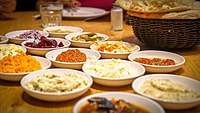Israeli style hummus
Israeli style hummus is an Israeli variety of hummus, popular both in its place of origin, as well as at hummusiyot and fine dining restaurants serving Israeli cuisine abroad.
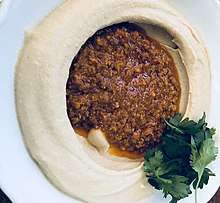 | |
| Alternative names | Israeli hummus, chummus, hummus tahini, buttercream hummus |
|---|---|
| Course | Breakfast, lunch, dinner, mezze, appetizer |
| Place of origin | Israel |
| Serving temperature | Warm, sometimes hot or room temperature depending on the variety |
| Main ingredients | Chickpeas, tahini, lemon juice, garlic, cumin, kosher salt, rarely olive oil |
Overview
Israeli style hummus is a style of hummus originating in Israel, that is popular both in Israel and abroad, that is renowned for its quality,[1] its creamy, buttercream-like texture and its rich, nutty flavor due both to the quality and the quantity of tahini used in its preparation. It is commonly prepared by Israelis of all backgrounds, and has been said to be the national dish of Israel. It can be commonly found at specialty restaurants only serving hummus called, hummusiya, as well as fine dining, casual and fast food restaurants across Israel and at restaurants serving Israeli cuisine abroad. It is also commonly served at stalls and eateries in shuks throughout the country such as the Machane Yehuda market in Jerusalem. Israeli style hummus is also found in refrigerated, mass-produced form in grocery stores and convenience stores throughout Israel, made by brands such as Osem and Sabra, among others; oftentimes in collaboration with popular hummusiyas in the country.[1]
Israeli style hummus is often served as a dish on its own, but is also commonly incorporated into other dishes and used a condiment with such popular dishes as falafel, chicken schnitzel sandwiches, shawarma sandwiches, sabich, and many others.[1] It is also a common filling in many popular pastries in Israel such as bourekas, sambusak, and even sufganiyot, among others.
Texture
"With a texture so creamy from whizzing in lemon and tahini that the millennia-old idea of crushed chickpeas felt like a freshly devised novelty."[2]
— Bill Addison, Eater
The texture of Israeli style hummus is different from many other styles of hummus. The texture of Israeli style hummus varies, but it generally is very rich, smooth and creamy with a nutty taste from the liberal use of tahini in Israeli style hummus.[3] The texture of Israeli hummus has been likened to buttercream by the New York Times,[4] and has also been called creamy, dreamy and revelatory.[5]
Types
"Israeli hummus is mostly about the tahini, I think the misconception is that it should be the garlic and lemon juice, and that’s actually a small part. It depends on where you are regionally, but I think that’s what sets it apart. The temperature, too. It's not cold; they make it and then serve it."
Israeli style hummus is commonly topped with a wide variety of toppings ranging from fried cauliflower to shakshouka.[7] There are many different toppings and types of Israeli style hummus, some of which are listed below.
Hummus tehina
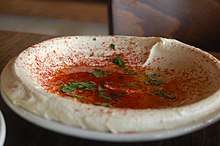
Hummus tehina is a variant of Israeli style hummus, that contains chickpeas, tahini (tehina in Hebrew), lemon juice, garlic, cumin, salt, and rarely it may contain olive oil. This is the most common variety of hummus in Israel, and it is made by both Jewish and Arab Israelis. It is traditionally made as a combination of chickpeas and tahini, or through the combination of the aforementioned ingredients. Unlike other varieties of hummus, the emphasis in hummus tehina is on the combination of chickpea and tahini, whereas other Middle Eastern styles of hummus typically have more garlic and lemon flavor, have many different consistencies (some grainy, some not), and often have less of a variety of toppings than hummus tehina.[1]
It is topped with olive oil and parsley, and can also be topped with paprika (smoked paprika is most common), za'atar, and other spices. It can be topped with a variety of toppings such as pine nuts, zhoug, spiced ground beef, lamb, chicken salad, falafel, Jerusalem mixed grill, and much more.[1]
Hummus ful
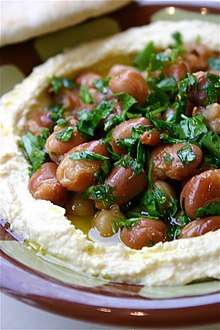
Hummus ful is the third most popular variant of hummus in Israel. It consists of hummus topped with warm ful medames, a heavily seasoned fava bean stew of Egyptian origin that was introduced to Israel by Arab Jewish immigrants. Ful medames has been prepared as a Shabbat stew by the Egyptian Jewish community for thousands of years.[8]
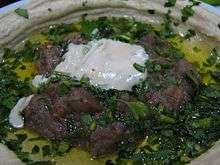
However, many people of Mediterranean origin, Mediterranean Jews in particular, have a disease called favism, which can cause life-threatening complications from eating fava beans.
Machane Yehuda hamshuka
Hamshuka is a dish invented by chef Uri Avney who runs a restaurant the Machane Yehuda shuk in Jerusalem, Israel, who tops his Israeli hummus with a topping which incorporates either the steak leftovers[9] or ground beef and lamb from the restaurant with the Yemenite Jewish spice hawaij, along with pine nuts, tomato, and spices.[10]
Hamshuka

A variety popular in restaurants in Jerusalem and Tel Aviv, as well as Israeli restaurants abroad combines Israeli style hummus with shakshuka. This sometimes includes merguez.
Hummus Pitryot (Hummus with Mushrooms)

Hummus Pitryot, also known as hummus with mushrooms is a variety of Israeli-style hummus topped with sautéed mushrooms, often maitake mushrooms.[1] Israeli style hummus with mushrooms is commonly served at hummusiyas and other restaurants offering hummus throughout Israel, and is also often made with roasted or sautéed mushrooms such as baby bellas, along with caramelized onions and toasted pine nuts.[7]
Jerusalem hummus
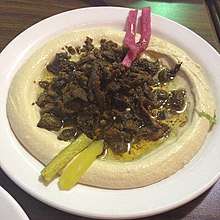
Jerusalem hummus is a dish consisting of Israeli-style hummus that has been topped with toasted pine nuts and warm, spiced ground beef or lamb that has been browned and seasoned with spices such as baharat. This variety has been called "The Best Hummus" by VICE.[11] Instead of topping the hummus with olive oil (as is common with other varieties), the hot beef or lamb fat takes the place of olive oil in this dish. It is very popular in Jerusalem, particularly during the winter and is a unique variety of hummus as it contains meat and most hummus is both vegan and pareve.[1]
Hummus masabacha
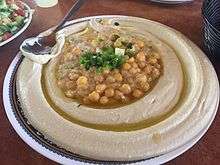
Hummus masabacha is a common variant of Israeli-style hummus, which consists of Israeli-style hummus that has been topped in its center with masabacha, or cooked chickpeas served warm and tossed in a sauce containing tahini, garlic and lemon juice. This is a very popular variant of hummus commonly served in Israel[1] Jewish Israeli restaurants tend to serve Hummus Masabacha hot, and is traditionally eaten by the “bowlful” similar to a stew, and is traditionally served with haminados, a slow cooked egg of Sephardi Jewish origin, somewhat similar to a hard boiled egg, that has a unique creamy texture and brown exterior due to its being cooked for many hours, often overnight, as part of the traditional Sephardic Shabbat stew, hamin, from which it derives its name,[12] and some pita for dipping. At a hummusiya in Haifa, this is also served topped with whole chickpeas or cooked mushrooms, as well as some Galilean olive oil, with an array of housemade hot sauces on the dining table such as zhoug, harissa, and a unique lemon juice concoction that has been infused with crushed garlic cloves.[13]
Hummus Darfur
Hummus Darfur is a variant of Israeli style hummus which originated with the Sudanese refugees given refuge in Israel. Hummus Darfur combines Israeli style hummus topped with Sudanese style ful, a hard boiled egg, grated tomato, tahini sauce, and boiled chickpeas and is served at Hummus Gan Eden, a restaurant operated by Sudanese refugees in South Tel Aviv.[14]
Hummus Komplete
Hummus Komplete is a common variant of Israeli style hummus which is found at hummusiyas thoroughout the country. It is similar to hummus ful, but has a few key differences. One difference is that Hummus Komplete consists of Israeli style hummus which has been topped with ful in the well in its center, and is then paired with a hard boiled egg (called beitza in Hebrew). The pairing of the beitza with hummus ful, is what makes a hummus ful into Hummus Komplete, and is a pairing unique to Israel and its origins are unknown[15] but it likely originated with the cuisine of the Mizrahi Jews.
Hummus Tznobar (Israeli style hummus with pine nuts)
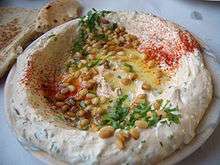
Hummus Tznobar is a variant of Israeli style hummus topped with pine nuts (tznobar in Hebrew).[16] Israeli style hummus is commonly topped with toasted pine nuts, that have either been toasted dry, or briefly pan-fried in olive oil or butter.[17] This is also one of the most popular packaged flavors of Israeli style hummus, and is offered by many brands such as Sabra.[18]
Jaffa Hummus
Jaffa Hummus is a unique variant of Israeli style hummus which is made in a mortar and pestle, and was invented by Israeli chef Erez Komsrovsky, owner of the Israeli restaurant Mint Kitchen in New York City. This variety of hummus is made with chana dal, an Indian bean similar to a chickpea, instead of the traditional chickpeas used in most Israeli hummus. This dish also incorporates a jalapeno pepper (which is not a traditional ingredient found in Israeli style hummus), as well as a large volume of garlic. The use of chana dal lends this hummus a darker brown color compared to the usual lighter color of other Israeli style hummus. However its high tahini content is typical of Israeli style hummus, and the toppings commonly served with it are also more traditional such as toasted pine nuts, roasted mushrooms, etc.[19][20][21]
Beet hummus
Beet hummus is a variant of Israeli style hummus which incorporates beets, which are popular in Ashkenazi Jewish cuisine. Beet hummus originated in Tel Aviv, and is popular in fine dining restaurants there. It consists of Israeli style hummus which has had cooked beets added to t before the hummus itself has been puréed. The beets lend this Israeli hummus a pinkish-red color.[22][23]
Hummus Mashawsha
Hummus Mashawsha, also known as חומוס משאוושה in Hebrew, is a popular variant of Israeli style hummus originating in the Upper Galilee region of Northern Israel. Mashawsha is somewhat similar to masabacha, although with a few key differences. Mashawsha is made with chickpeas that have been crushed prior to cooking, which results in the cooked chickpeas taking on a more paste-like consistency compared to the whole chickpeas used in Hummus Masabacha. These cooked, cracked chickpeas are then combined with the other ingredients typical of other styles of Israeli hummus, such as tahini (although not much tahini is used in this variety), lemon juice and garlic, to create a unique variety of hummus that has a texture similar to a chunky stew. Hummus Mashawsha is served in a bowl with a "swoop" of a spoon, and is often topped with whole cooked chickpeas and a liberal amount of olive oil. The flavor and texture of Hummus Mashawsha differs from other varieties of Israeli hummus. It has been described as having not having much tahini flavor, and having a strong lemon flavor, and a sharp bite from the chunks of chopped garlic used in its preparation.[24] The texture of Hummus Mashawsha is likewise, very unique, and appears to be lumpy but tastes very smooth, and has been likened to that of a hot custard.[25] It can be found throughout Israel, but is most common in the north of the country and in Tel Aviv. It is in Tel Aviv, where a restaurant dedicated to this dish exists, where hummus mashawsha is paired with Israeli pickles, Israeli salad, a green hot sauce similar to zhoug, red cabbage and other salads.[16]
Hummus Ashkara
Hummus Ashkara is a unique variant of Israeli style hummus, originating at the eponymous restaurant of the same name, Hummus Ashkara, a popular hummusiya in Tel Aviv founded in 1994 by an Israeli couple, Dan and Ruth Tavor,[26] which has been said to be a "local institution" and to be frequented by local celebrities. This particular variant of Israeli style hummus is only served at this restaurant, and has a unique, very thick texture unlike other types of Israeli hummus, which are typically thinner due to the quantity of tahini used. The flavor of Hummus ashkara is said to not be very spicy, and does not contain much spice as the flavor of the chickpea itself is the main flavor of this Israeli hummus.[16] Hummus Ashkara is served hot, and topped with cooked chickpeas and a hard boiled egg,[26] also known as a beitza.[27] Another variant of Hummus Ashkara has the same, thicker texture than other Israeli style hummus, but also has a stronger garlic and lemon flavor.[28]
Jaffa style Hummus
Jaffa style hummus, not to be confused with the aforementioned Jaffa Hummus, is a variant of Israeli style hummus originating in the Tel Aviv-Yafo Area, and popular in the United States, particularly in the Bay Area. It can refer to two different types of Israeli style hummus.
The first type of Jaffa style hummus is an adaption of Hummus Ashkara, that was invented by Israeli-American tech entrepreneur Oren Dobronsky and chef David Cohen at their restaurant, Oren's Hummus Shop, which has several locations in Palo Alto and the Bay Area, and is available at Levi's Stadium as well. Dobronsky and Cohen were inspired by the Israeli hummus they enjoyed at the aforementioned Hummus Ashkara on a trip to Tel Aviv, and developed their own American adaption of this variant of Israeli style hummus. This Israeli hummus is offered at their restaurant, and is similar to the other variants of Israeli style hummus they offer, except for its much thicker texture and stronger garlic and lemon flavor, and more pine nuts, olive oil and parsley added.[29][28][30]
The second type of Jaffa style hummus is a variant of Israeli style hummus very similar to hummus tehina, and is an Israeli hummus with a creamy, airy, light texture, and a nutty flavor from the high tahini content of this hummus. This Jaffa style hummus likely originated in Jaffa, and is commonly served at hummusiyas in the city.[31] This term is mainly used abroad, in countries such as Australia, the United Kingdom and the United States, to denote Israeli style hummus.[32]
Galilee style hummus
Galilee style hummus, also sometimes known as Hummus Maushaushe,[33] or Hot Hummus[34] is a type of Israeli style hummus originating in the Upper Galilee region of HaZafon, Northern Israel. Galilean style hummus is very commonly served in Northern Israel, but can also be found in Tel Aviv, Jerusalem, and abroad. Its characteristics may vary, but it has a few fundamentals. It is traditionally served hot,[35][36] while most other Israeli style hummus is served warm or room temperature. It is traditionally topped with a liberal amount of local Galilean olive oil. Many varieties of Galielean style hummus are a unique combination of a creamy, airy style Israeli style hummus (such as the aforementioned hummus tehina), with the addition of some cooked chickpeas which are either lightly mashed, left whole,[37] or cooked until they are falling apart. Some varieties of Galilean style hummus are smooth and creamy and are distinguished from other varieties and Israeli hummus because they are served hot with a generous amount of local olive oil on top.[38]
Shlisha
Shlisha is a variant of Israeli style hummus. Shlisha originated in the Upper Galilee area in 2003, with the opening of local hummusiya, which has since expanded, with a subsequent opening of a second location in Tel Aviv, where Shlisha is now more commonly found.[39] It is a combination of three types of Israeli style hummus served together in one dish, Israeli Hummus Tehina, Hummus Mashawsha, and Hummus Ful are combined on the same plate, though they are not mixed together and remain separate. Israeli Hummus Shilsha is topped with olive oil and a sliced haminado, a slow-cooked egg of Sephardic Jewish origin somewhat similar to a hard boiled egg,[40] that has a unique creamy texture and brown exterior due to its being cooked for many hours, often overnight, as part of the traditional Sephardic Shabbat stew, hamin, from which it derives its name.[12]
Curried Onion and Cauliflower Hummus
Curried Onion and Cauliflower Hummus is a variant of Israeli style hummus invented by Israeli American chef Alon Shaya at his eponymous New Orleans restaurant, Shaya, which served Israeli cuisine. This variant of Israeli style hummus consists of a classic Israeli style hummus (similar to a Hummus Tehina), which has been topped with Israeli fried cauliflower and fried onions that have been seasoned with curry powder. This dish is one of the signature dishes at his restaurant, and is a very popular dish in the city of New Orleans.[41][42] Curry is not a commonly used ingredient in Israel, however fried cauliflower is a very popular dish in Israel, and is often used to top hummus in Israel as well.[43] The use of fried cauliflower in this dish is a nod to its popularity in restaurants in Israel, where it is often served with mint[44]
Israeli style hummus with chicken livers and caramelized onions
Israeli style hummus with chicken livers and caramelized onions is a variation of Israeli style hummus. In Ashkenazi Jewish cuisine, chicken livers are considered a traditional food and are traditionally prepared by browning or sautéing them with caramelized onions. This type of Israeli style hummus is a result of the fusion of Ashkenazi and Mizrahi Jewish cuisine, typical of modern Israeli cuisine. It is a commonly gsriety of Israeli hummus, and can be found in restaurants throughout the country as well as in those serving Israeli cuisine abroad.[45][46][47]
Serving
.jpg)
It is traditionally served at hummus restaurants in Israel with freshly-baked pita or laffa bread, although onion is also a popular dipping accompaniment, as well as a bottle of harif (an Israeli hot sauce similar to harissa), and often some olives and pickled vegetables such as Israeli pickles. It is a very common breakfast in Israel, although it is also eaten for lunch, dinner, or as part of a mezze.[1]
Accompaniments
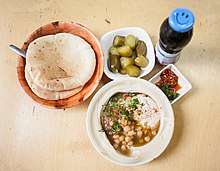
Israeli style hummus is rarely served on its own, and is commonly a meal in of itself, and is frequently paired with a number of traditional accompaniments in Israel.
Israeli pickles
Israeli pickles are almost always served alongside Israeli hummus in restaurants across the country, and serve as both a palate cleanser (due to their strong, acidic flavor), as well as an accompaniment because they pair well with the hummus.[48]
Zhoug
Zhoug, an Israeli hot sauce of Yemenite Jewish origin consisting of Jalapeño chilis, cilantro, lemon juice, olive oil and (often spices such as fenugreek), is a traditional accompaniment to hummus in Israel. Israeli style hummus is almost always paired with some sort of hot sauce.[49]
Harif
Harif is a popular Israeli hot sauce similar to harissa, whose name is derived for the Hebrew word for spicy, and is made from red chilis, kosher salt, garlic, olive oil and vinegar. It is commonly paired with Israeli style hummus.[47]
Beitza (Hardboiled Egg)
Beitza, the Hebrew word for hard boiled egg, is a common Israeli style hummus that is unique to Israel. The origin of this pairing is likely unknown,[15] but likely originated within Jewish cuisine (as hard boiled eggs are a common, traditional food among most Jewish ethnic divisions).[48]
Onion petals
Israeli style hummus is commonly served with "onion petals", or pieces of onions, in hummusiyas across the country. The onions used for these onion petals are typically white onion, as well as the not commonly-known pita or laffa bread. This pairing originated in the 1950s in Israel, as onions are one of the most inexpensive vegetables and were plentiful during that time. In the early days of the modern State of Israel, rations were in effect and poverty was widespread in the country, making pita bread too expensive for some to eat with Israeli style hummus.[48][50]
Impact in Israeli culture
"Ask any Israeli to point out one thing that embodies 'Israeliness'. Chances are nine out 10 will say 'hummus'."
.jpg)
Israeli style hummus is an essential part of Israeli culture and has been called the national dish of Israel, and it is commonly eaten by Israelis of all ethnic and socioeconomic backgrounds, especially as a breakfast. Many of the most popular hummusiyas in Israel prepare the hummus to order, and close for business when they run out of hummus by midday.[1]
Israeli style hummus has inspired a number of phrases and slang commonly used in Hebrew related to the dish and its consumption, as this is a very popular activity in Israel.
These include the following phrases:
N alav!- an exclamatory phrase used to describe Israeli hummus that is perceived to be exceptional.
Y, y, y!- an exclamation used when someone's mouth is full but they want to express that they enjoy the taste of their chummus, similar to the use of mmm in English.
Bo Le'nagev?- a phrase translating to "come, let's go wipe", referring to the Israeli custom of dipping (or, more literally, "wiping") Israeli style hummus.[15]
Popularity in Israel
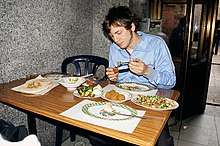
"Hummus is the common denominator for all Israelis. Ask an expatriate what he misses most, watch two Israelis argue for hours about where the best hummus is served, or try driving through the hummus-eateries filled streets of Jaffa on a Saturday and you'll understand: Israelis simply love their hummus."
— Shooky Galili[15], Ynetnews

Israelis eat over 35,000 tonnes of Israeli style hummus each year,[51] with the average Israeli consumes 22 lbs (10 kg) of Israeli style hummus per year.[15]
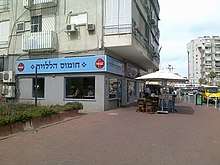
According to Israeli hummus manufacturer Sabra Salads, Israelis consume more than twice as much hummus as their Arab neighbors[52]
According to a 2016 study conducted by Diners Club International to coincide with the celebration of Yom Haatzmaut, or Israeli Independence Day, most Israelis surveyed were found to eat Israeli style hummus more than twice a week, with 93% of Israelis were found to eat Israeli style hummus at least more than once a week, and with 5% of Israelis reporting that they eat hummus 6 times a week. The study also found that 70% of Israelis had some Israeli hummus in their fridge at all times. In addition to these findings, 30% of respondents said that Israeli hummus is "Israel's national dish", 60% of Israelis surveyed reported buying their hummus at grocery stores, while 15% of Israelis said they purchased their hummus from hummusiyas and other restaurants, while 13% of respondents reported making their own Israeli style hummus at home, with adults over the age of 55 reported to be more likely to make their own hummus at home. The most popular toppings according to the survey were tahini (at 38%), followed by cooked chickpeas or masabacha at 23%. 9% of Israelis viewed Israeli style hummus as a symbol of Jewish Arab coexistence. The most common method of eating hummus in Israel was reported to be wiping the hummus with pita in a circular motion, with over half of Israelis saying this was their preferred method of consumption.[53][54]
Popularity in the United States
In the United States, Israeli-style hummus has become very popular, especially since the 2010s. It has been called the "most-talked about recipe"[55] is commonly found in restaurants serving Israeli cuisine, (both fine-dining and casual), such as Bavel, Zahav, Kismet, Balaboosta and many others, as well as Israeli chain restaurants such as Naf Naf Grill. Israeli style hummus is also sold in grocery stores across America, by popular brands such as Sabra and Tribe, among others.
Los Angeles
Bavel, a restaurant in Downtown Los Angeles is best known for its hummus served with duck nduja, as well as other varieties of hummus, which Chef Ori Menashe has said is inspired by his youth in Israel, and specifically the Palestinian hummusiya Abu Hassan in Yafo.[56][57][58][59][60][61][62][63][64]
Philadelphia
Zahav is an Israeli restaurant in Philadelphia which is particularly acclaimed for their authentic, Israeli-style hummus, which is very creamy and has a high tahini content, and is offered with a wide range of toppings available.
American food magazine Bon Appétit named hummus its "2015 Dish of the Year",[65] and in particular characterized the hummus tehina served at the Israeli-style hummus restaurant Dizengoff in Philadelphia as "the creamiest, dreamiest hummus".[66]
Popularity in other countries
Israeli style hummus is available in many countries in the world. Packaged variants are available in grocery stores in certain countries abroad. It is also featured in the menu of many kosher restaurants, and restaurants serving Israeli cuisine, also known as Israeli restaurants; where it is often called Israeli style hummus, hummus, Jewish hummus, kosher hummus, or Israeli hummus.[50]
Australia
Israeli style hummus can be found at restaurants serving Israeli cuisine throughout Australia, but particularly in the cities of Melbourne, Sydney and Brisbane, all of which have a significant Jewish population. Israeli chain Miznon operates a location in Melbourne and there are also several locally based restaurants offering Israeli style hummus and other Israeli cuisine such as New Jaffa, Tavlin, The Left Handed Chef, Green Man's Arms, Danny's, and more.[67]
Cyprus
Israeli style hummus is available throughout the island of Cyprus, due to it being a popular Israeli tourist destination. A number of kosher restaurants serving Israeli cuisine offer Israeli style hummus, especially in Larnaca, which is a popular destination for Israelis to visit on holiday, such as Sambation.[68] A local rabbi at the Larnaca Chabad house, Shneor Levitin, brought Israeli hummus to Israeli teenagers who had been falsely accused and imprisoned by Cypriot authorities in 2019, as the official Chabad policy to provide food to any Jew in need.[69]
France
Israeli-style hummus is commonly found at restaurants serving Israeli cuisine in France, mostly in Paris, especially in the Pletzel neighborhood of the Le Marais or "Jewish quarter". It can be found at L'As du Fallafel, a kosher restaurant offering Israeli style hummus, as well as falafel and other Israeli sandwiches. In addition, it is also one of the signature dishes at the Israeli restaurant chain Miznon by Israeli chef Eyal Shani, which has two locations in Paris, including one location in the Le Marais neighborhood. Israeli style hummus can also be found at Tavline, a restaurant serving Israeli cuisine that is also located in The Marais,[70] a historically Jewish neighborhood which has remained the center of French Jewry for hundreds of years despite the Holocaust and the terror attacks against Jews in recent years.[71]
Hong Kong
Israeli style hummus can be found at restaurants serving Israeli cuisine in Hong Kong such as FalafelTLV, a popular restaurant in the Central neighbourhood of Hong Kong, which offers Israeli hummus with a variety of toppings as well as falafel and other Israeli sandwiches[72] The restaurant imports all ingredients it uses for its Israeli style hummus and other dishes from Israel, and also offers a variety of these Israeli products for sale at its neighboring gift shop.[73]
India
Israeli style hummus can be found in India, which cater both to the local population as well as Israeli, American, and other Jewish tourists. It can be mostly commonly found in Mumbai, which has Moshe's, a chain of cafes offering Israeli cuisine.[74] Many Israelis visit India and travel the country after their mandatory conscription in the IDF, and this phenomenon has been dubbed the "Hummus Trail". Restauranrs Serving Israeli hummus and other Israeli cuisine such as sabich, shakshouka, and schnitzel can be found in villages with a significant Israeli tourist population, such as Vattakanal, which has been called "Little Israel".[75][76]
Italy
Israeli style hummus can be found in kosher restaurants across Italy, mainly the former Jewish ghettos in Milan, Venice and Rome, and largely cater to local Italian Jews as well as Jewish tourists from around the world.
In Venice, kosher restaurants such as the Ghimmel Garden,[77][78][79] which was founded by local Venetian Jews. As well as Gam Gam Kosher offer Israeli style hummus and other Jewish cuisine in their restaurants which are located in the Venice Ghetto, which was established in 1516 and is the oldest Jewish ghetto in the world[80][81][82]
In Rome, Israeli style hummus and other Israeli and Jewish cuisine is offered at Su Ghetto, a kosher restaurant which is located in the historic Rome Ghetto[83][84]
In Milan, Israeli style hummus is offered in kosher restaurants serving Israeli cuisine throughout the city such as Carmel, Denzel, and Ba'Ghetto, among others.[85]
Jamaica
A variant of Israeli style hummus exists in Jamaica, which combines the traditional ingredients of Israeli hummus with the addition of a scotch bonnet pepper[86]
Japan
"Israeli food is becoming super trendy in this country, and hummus is leading the charge because people here are already used to the idea of bean paste from their local food. It just fits."
— Rabbi Binyomin Edery[87]
Israeli cuisine in general has become very popular in Japan beginning in the 2000s, especially Israeli style hummus, which has become available in Japan in the last few decades.[88] There are at least 8 Israeli restaurants serving Israeli style hummus in Japan as of 2015, mostly in the capital city of Tokyo, with one restaurant serving Israeli cuisine located in Sendai, a city in northern Japan. The majority of Israeli style hummus available in Japan is not certified kosher, however there is one kosher restaurant in Tokyo at the local Chabad House, called "Chana's Place", which serves Israeli hummus and others Israeli cuisine.[87][89]
Israeli cuisine, and Israeli hummus in particular, has been said to have become popular in Japan due to the health consciousness of the local population, many of whom wish to consume a healthy diet.[87][89]

The longest-running Israeli restaurant in Japan is a restaurant called Shamaim, located in the Toshima-Ku ward of Tokyo. This restaurant offers Israeli style hummus, along with other Israeli dishes in an all-you-can-eat format such as falafel, chicken schnitzel, shakshouka and kebabs, as well as traditional Israeli live entertainment such as belly dancing. The oldest falafel restaurant in Japan is a restaurant called "Pita the Great", which has been open since 1993 and offers Israeli cuisine such as falafel, Israeli salad, and Israeli style hummus. This restaurant is unique in Japan, as they bake their own pita on site and offer Israeli style hummus in packaged form (as well as other Israeli dips such as tehina and harissa), and offer it for sale at their restaurant as well as at the National Azabu Supermarket in the Azabu district of Tokyo.[90][91]
David's Deli is another restaurant which offers Israeli style hummus, as well as other traditional Israeli dishes, as well as Jewish delicatessen dishes such as matzo ball soup, gefilte fish and p'tcha. It is owned by an Israeli expat and the hummus and other dishes are made by a Japanese chef who was trained by Israeli chefs.[90][89]
TA-IM, (meaning 'delicious' in Hebrew), is an Israeli restaurant opened by Israeli businessman Dan Zuckerman, which opened in 2011 in the Shibuya ward of Tokyo. The restaurant mimics the hummusiyas of Tel Aviv, and specializes in Israeli hummus (and also offers Israeli style hummus with meat/Jerusalem hummus) and other Israeli cuisine such as falafel, chicken schnitzel, mujadra, kebabs on cinnamon sticks and malabi. The restaurant plays the popular Israeli radio station, Galgalatz, in the background as part of its "Israeli aesthetic". TA-IM is a small restaurant which only seats 16 people, compared to the larger aforementioned restaurants.[89] Hidehiko Egata, a customer of TA-IM who works in finance said in an interview with JTA, "I first ate hummus a few years ago on the other side of town, I found that it was more healthy than my usual dinners then. It was filling, but it didn’t make me tired the way a noodle dish would. When this place opened, it became my regular spot.".[92][93][87]
"If this restaurant is to succeed, it needs to appeal to the Japanese public. The Jewish, kosher-observing community is too small to sustain this business."
— Rabbi Mendy Sudakevich, Chabad of Tokyo
Chana's Place is a kosher restaurant offering Israeli style hummus and other Israeli cuisine owned by the Chabad of Tokyo, which is located in the Minato-ku neighborhood of Tokyo, and is run by Rabbi Mendy Sudakevich, who also served as Chabad's envoy to Japan. The restaurant is named after his wife (Rebbetzin). Chana's Place has been designed to appeal more to the local Japanese population of Tokyo, as the Jewish community of Tokyo has only been estimated to number several hundred people. According to Rabbi Sudakevich, "The Japanese marry an almost impossible mix of hunger for new stuff with a deep conservatism," Sudakevich said. "If you want to serve them something new, you need to make sure you do it in familiar ways.".[87][89]
The Japanese and Israelis have different methods of eating hummus, and this restaurant has accommodated the local eating customs. In Israel, hummus is traditionally consumed by "wiping" it off the plate with pita. In Japan, it is more common for the pita to be cut into small pieces, and the hummus is then placed on the bread to horn "hummus sandwiches". The profits from this restaurant are used to help fund the local Chabad movement's activities and services for the Jewish community.[87]
Another restaurant serving Israeli cuisine is called "King Falafel", and is a kosher food stand also operated by the Chabad house and offers Israeli style hummus and falafel.[87][89]
Israeli style hummus is much more expensive in Japan compared to its cost in Israel, and many other countries around the world, due to the large amount of tahini used in its production and the high costs of importation of tahini from Israel to Japan. In 2015, the average price for 100 grams (3.5 ounces) of Israeli style hummus in Japan was US$6.[94]
Mexico
Israeli style hummus is available in Mexico and is commonly served at restaurants offering Israeli cuisine which are located throughout the country but mostly in Mexico City. Merkava, an Israeli restaurant in the La Condesa neighborhood of Ciudad de Mexico offers an Israeli style hummus which they serve with flatbread made in house[95][96]
Morocco
In Morocco, which was once home to a very large, thriving Jewish community prior to their forced expulsion in the 20th century, there are several restaurants offering Israeli style hummus, mainly in Casablanca.[97]
New Zealand
Israeli style hummus can be found in Israeli restaurants throughout the country which mainly cater to the small, local Jewish community as well as Israeli tourists and expats. It is served st restaurants such as Doof Doof[98] and Hummus and Falafel[99] in Auckland, as well as Falafel Gourmet Cafe In Nelson.[100]
South Africa
Israeli style hummus is available at kosher restaurants as well as at restaurants serving Israeli cuisine (that mainly cater to Jewish South Africans and Israeli tourists and expats) across South Africa, but particularly in the cities of Cape Town and Johannesburg. In Cape Town a kosher restaurant called “Noa Hummus” offers Israeli style hummus.[101] And in Johannesburg, Israeli hummus can be found in restaurants such as Tei Avon, Schawarma Company, Eat Your Heart Out and Teta Mari Bistro.[102]
St. Martin/Maarten
Israeli style hummus is served at an Israeli restaurant in Simpsons Bay in Saint Martin/Sint Maarten, called Little Jerusalem.[103]
Switzerland
Israeli style hummus is served at restaurants offering Israeli cuisine, as well as at kosher restaurants throughout the country, but mainly in Zurich and Basel.
NENI, an Israeli restaurant chain with locations across Europe, offers Israeli style hummus at their two locations in Zurich.[104][105][106][107]
Israeli style hummus is also served at Flavors of Israel, a food stall in the local markthalle offering Israeli cuisine in Basel.[108] Israeli style hummus is served at Le Jardin in Geneva, at a restaurant operated by the local Jewish community.[109]
In popular culture
- Israeli style hummus was one of the most important foods featured in the American documentary film In Search of Israeli Cuisine produced by chef Michael Solomonov and aired by PBS and later Netflix.
- Israeli style hummus was featured in the American Netflix original series Somebody Feed Phil, during the episode in which host Phil Rosenthal visited Israel. Israeli hummus was featured once again in the series when Rosenthal visited Israeli-American chef Alon Shaya namesake New Orleans restaurant, Shaya, offering Israeli cuisine.
- Israeli style hummus was mentioned in the American comedy television series, Broad City in the episode the lead characters (played by Ilana Glazer and Abbi Jacobson) were set to go on a Birthright trip to Israel.
- Israeli style hummus was mentioned by the title character in the 2006 American comedy film, You Don't Mess With The Zohan, played by Adam Sandler who portrays an Israeli hairdresser and former Mossad agent in the film. In the film Sandler's character can be seen eating Israeli hummus and makes several references to it.
- Israeli style hummus is mentioned in a parody of West Side Story, the 2005 short film West Bank Story features a rivalry between two fictional restaurants, the Israeli Kosher King and the Palestinian Hummus Hut. The film won the 2006 Academy Award for Best Live Action Short Film.[110]
- Israeli style hummus is featured in the American travel series Anthony Bourdain: Parts Unknown, in an episode in which host Anthony Bourdain visits Israel and eats Israeli hummus theout the country.
- Israeli style hummus is featured in the American travel series Bizarre Foods: Delicious Destinations in the "Tel Aviv" episode in which host Andrew Zimmern showcases several restaurants serving the dish in the city.
- Israeli style hummus is featured in the American travel series A Cook's Tour in which host Anthony Bourdain visits Israel and is seen consuming Israeli hummus.
- Israeli style hummus is featured in the American travel series Rick Steves Europe in the "Israel" episode in which host Rick Steves travels the country and samples Israeli hummus throughout his travels.
- Israeli style hummus is featured in the American travel series Anthony Bourdain: No Reservations in which host Anthony Bourdain visits Israel and samples hummus in Jerusalem and Tel Aviv.
- Israeli style hummus is mentioned in an episode of the American HBO comedy series "Curb Your Enthusiasm" created by Larry David.
- This dish is commonly featured in the Israeli series, the Beauty and the Baker, as the family of one of the main character's in the series, Amos Dahari (played by Aviv Alush), owns a bakery which baked pita and laffa which are commonly served with hummus in the series.
- This dish is featured in several episodes of the Israeli comedy series HaShoter HaTov, in which several of the main characters go out to a hummusiya to wipe some Israeli hummus. It is also seen in the home of the main character in one episode. In another episode, packaged varieties of Israeli style hummus can be seen in the refrigerated section in a grocery store.
See also
- Hummus tehina
- Cuisine of Israel
References
- Solomonov, Michael. Zahav. HMH.
- Addison, Bill (2015-07-08). "Why Philly's Mike Solomonov Is The Genius of Modern Jewish Cooking". Eater. Retrieved 26 October 2019.
- "Israeli-Style Hummus". Fine Cooking. Retrieved 26 October 2019.
- "Zahav review". NYT. NYT. Retrieved 26 October 2019.
- "Why Philly's Mike Solomonov Is The Genius of Modern Jewish Cooking". Eater Philly. 2015-07-08. Retrieved 26 October 2019.
- "A Hummus Crawl Through Israel With the 'Chickpea Whisperer'". VOGUE. Retrieved 26 October 2019.
- "Israeli Hummus topped with Mushrooms, Caramelized Mushrooms and Pine Nuts". Global Table Adventure. Retrieved 27 October 2019.
- Marks, Gil. The Encyclopedia of Jewish Food. HMH.
- Martha Stewart https://www.marthastewart.com/893034/hamshuka-tahigorut-and-machneyuda-toppings. Retrieved 20 October 2019. Missing or empty
|title=(help) - "Hamshuka with Hawaij". Woodland Foods. Retrieved 20 October 2019.
- "This 'Jerusalem Topping' Is the Secret to the Best Hummus". VICE. VICE. Retrieved 26 October 2019.
- Cook, Steven. "Israeli Soul". Missing or empty
|url=(help) - "Like Your Hummus Chunky? Try Whole-Chickpea Masabacha". Hadassah Magazine. 2019-08-21. Retrieved 28 October 2019.
- "Hummus Darfur". Mental Manna. 2012-06-30. Retrieved 26 October 2019.
- Galili, Shooky. "Land of hummus and pita". Ynetnews. Ynetnews. Retrieved 27 October 2019.
- "Where To Eat The Best Hummus In Tel Aviv". Go Tel Aviv. Retrieved 28 October 2019.
- Israeli Soul.
- "PINE Nut Hummus". SABRA. Retrieved 27 October 2019.
- "Recipe: Jaffa Hummus". Michelin Guide. Retrieved 27 October 2019.
- "MINT Kitchen review". Gothamist. 2019-02-19. Archived from the original on 27 October 2019. Retrieved 27 October 2019.
- "Warm Jaffa Hummus". Michelin Guide on Facebook Live. Retrieved 27 October 2019.
- "Beet Hummus". Union for Reform Judaism. 2015-03-30. Retrieved 28 October 2019.
- "Hot Pink Beet Hummus". LARK. Retrieved 28 October 2019.
- Brodsky, Zev (2015-01-19). "HUMMUS MASHAWSHA- A NORTHERN ISRAELI STYLE OF HUMMUS IN THE HEART OF TEL AVIV". Tel Aviv Affordable Dining. Retrieved 28 October 2019.
- "Hummus Mashawsha / חומוס משאוושה". Eating Hummus in Israel. Retrieved 28 October 2019.
- "Hummus Ashkara". World Jewish Travel. Retrieved 28 October 2019.
- "Beitza". Chabad. Retrieved 28 October 2019.
- "FOOD: Heavenly hummus". Daily Local. Retrieved 28 October 2019.
- "Menu". Oren's Hummus Shop. Retrieved 28 October 2019.
- "Best hummus in the Bay Area and hummus cooking tips". Mercury News. Retrieved 28 October 2019.
- "Elly's Hummus recipe (Jaffa)". Just Add Love. Retrieved 28 October 2019.
- "Authentic Jaffa style Hummus". Lion's Bread. 2017-05-28. Retrieved 28 October 2019.
- Komarovsky, Erez. "Hummus Mashaushe (Galilean-Style Hummus)". Saveur. Retrieved 28 October 2019.
- "Garger Hazahav / גרגר הזהב". Eating Hummus in Israel. 2018-09-25. Retrieved 28 October 2019.
- "Mabsuta / מבסוטה". Eating Hummus in Israel. Retrieved 28 October 2019.
- "Yosef's Hot Hummus / חומוס יוסף". Eating Hummus in Israel. Retrieved 28 October 2019.
- "7 Rules for Perfect Hummus". Jewish Journal. Retrieved 28 October 2019.
- "10 secret hummus places in Israel". Humus 101. Retrieved 28 October 2019.
- "7 Best Hummus Places In Israel". Gil Travel. Retrieved 28 October 2019.
- "ABU ADHAM- A TRUE TEL AVIV HUMMUS EXPERIENCE". Tel Aviv Affordable Dining. Retrieved 28 October 2019.
- "Curried Onion and Cauliflower Hummus". Food and Wine. Retrieved 28 October 2019.
- "New Orleans + RECIPE: Hummus with Curried Cauliflower". The Leek and the Carrot. Retrieved 28 October 2019.
- Solomonov, Mike. Zahav.
- "How to make the creamiest hummus ever". Food and Wine. Retrieved 28 October 2019.
- "Homemade Hummus With Chicken Livers or Eggplant". Haaretz. 2012-04-26. Retrieved 28 October 2019.
- "Variations of Hummus". Humus 101. Retrieved 28 October 2019.
- Cook, Steven. Israeli Soul.
- Marks, Rabbi Gil. The Encyclopedia of Jewish Food. HMH.
- Menashe, Ori. "L.A. Chef Ori Menashe Makes a Mean Hummus". Los Angeles Magazine On YouTube. Retrieved 27 October 2019.
- Cook, Steven. Israeli Soul. HMH.
- Kessler, Dana. "SEARCHING FOR 'REAL' ISRAELI FOOD". Tablet. Retrieved 27 October 2019.
- "Searching For Hummus In Israel". Moment Mag. Retrieved 26 October 2019.
- "Over 70% of Israelis have hummus in fridge". The Times of Israel. The Times of Israel. Retrieved 27 October 2019.
- "Hummus in 70 percent of Israeli refrigerators, poll shows". Jewish Telegraphic Agency Agency. JTA. Retrieved 27 October 2019.
- "Zahav's Hummus Recipe is Genius". Food52. 2016-03-23. Retrieved 26 October 2019.
- "DUCK 'NDUJA HUMMUS-ROASTED CAULIFLOWER-FRIED PITA". Chefs Feed. Retrieved 29 October 2019.
- "Instagram post about this hummus". Bavel DTLA on Instagram. Retrieved 29 October 2019.
- "Bavel Has the 2018 Restaurant Design of the Year". Eater.
- "Instagram post about this hummus". Chef Jay on Instagram. Retrieved 29 October 2019.
- "'LATIMES' NAMES ISRAELI RESTAURANT BEST OF 2019". The Jerusalem Post. Retrieved 29 October 2019.
- "Bavel Is Our 2019 Restaurant Of The Year". Los Angeles Times. Retrieved 23 November 2019.
- "Bavel Is Our 2019 Restaurant Of The Year (Youtube video by LA Times)". LA Times on Youtube. Retrieved 23 November 2019.
- "L.A. Chef Ori Menashe Makes A Mean Hummus". Youtube. Los Angeles Magazine. Retrieved 23 November 2019.
- "Life Changing Pitas At LA's Newest Middle Eastern Spot". Thrillist on Youtube. Retrieved 23 November 2019.
- Stanek, Amiel (August 18, 2015). "Hummus Is the 2015 Dish of the Year". Bon Appetit. Retrieved 12 December 2019.
- Stanek, Amiel (August 18, 2015). "The Secret to the Creamiest, Dreamiest Hummus". Bon Appetit. Retrieved 12 December 2019.
- "The Best Jewish Food In Melbourne". The Nosher/My Jewish Learning. Retrieved 26 October 2019.
- "Home Page". Sambation. Retrieved 26 October 2019.
- "Chabad Rabbi Brings Hummus To Suspects". Ha’aretz. Retrieved 26 October 2019.
- "A New Wave of Middle Eastern Food Comes to Paris". VOGUE. Retrieved 26 October 2019.
- "A Walk In The Marais". Ha’aretz. Retrieved 26 October 2019.
- "Falafel TLV Hong Kong review". The Dim Sum Diaries. 2017-08-14. Retrieved 26 October 2019.
- "FalafelTLV review". The Honeycombers. Retrieved 26 October 2019.
- "Best Hummus in Mumbai and New York". The India Edition. Retrieved 26 October 2019.
- "Along the 'Hummus Trail'". Ha’aretz. Retrieved 29 October 2019.
- "Vattakanal - The Bliss Test". Terrain Spotter. Retrieved 29 October 2019.
- "Home". Ghimmel Garden. Retrieved 26 October 2019.
- "Ghimmel Garden". Great Kosher Restaurants. Retrieved 26 October 2019.
- "Ghimmel Garden- contact, reviews, info". Totally Jewish Travel. Retrieved 26 October 2019.
- "Ghimmel Garden". Herblester.com. Retrieved 26 October 2019.
- "Menu". Gam Gam Kosher. Retrieved 26 October 2019.
- "Gam Gam Kosher review". Tripadvisor. Retrieved 26 October 2019.
- "Main (in Italiano)". Retrieved 26 October 2019.
- "Su Ghetto- Rome, Lazio". Tripadvisor. Retrieved 26 October 2019.
- "Best Kosher Restaurants in Milan". My Milan. 2018-03-19. Retrieved 26 October 2019.
- Spence, Nigel. "How To Make Jamaican Hummus". Carib Journal. Retrieved 26 October 2019.
- Lipshiz, Cnaan. "Japanese culinary curiosity gives hummus moment in the rising sun". Jewish Telegraphic Agency Agency. JTA. Retrieved 26 October 2019.
- "Hummus in Japan". Humus101. Retrieved 30 October 2019.
- "Konichiwa, Kneidlach: Tokyo's Israeli Food Scene Is Thriving". Ha’aretz. Ha’aretz. Retrieved 30 October 2019.
- "Pining for the communal flavor of Israeli cuisine". Japan Times. The Japan Times. Retrieved 30 October 2019.
- "Official Website (in Japanese)". Shamaim Tokyo. Retrieved 30 October 2019.
- "ISRAELI FOOD BIG IN JAPAN (ALRIGHT!)". Tablet. Tablet. Retrieved 30 October 2019.
- "In Japan, hummus and Israeli cuisine are getting their moment in the sun". The Jewish News of Northern California. The Jewish News of Northern California. Retrieved 30 October 2019.
- "Japanese culinary curiosity gives hummus moment in the rising sun". JTA. JTA. Retrieved 30 October 2019.
- "Merkava- Mexico City Eating Guide". Lonely Planet. Retrieved 26 October 2019.
- "Merkava- Website Oficial". Bull and Tank. Retrieved 26 October 2019.
- "Kosher restaurant review (hummus can be seen in the photos)". Tripadvisor. Retrieved 26 October 2019.
- "Doof Doof Hummus (Israeli style)". Doofdoof.nz. Retrieved 26 October 2019.
- "Hummus and Falafel in Auckland". Happy Cow. Retrieved 26 October 2019.
- "Best israeli hummus and falafel". Tripadvisor. Retrieved 26 October 2019.
- "Home page". Noa Hummus. Retrieved 26 October 2019.
- "Joburg's Best Middle Eastern and Turkish Restaurants". In Your Pocket. Retrieved 26 October 2019.
- "Little Jerusalem reviews". Tripadvisor. Retrieved 26 October 2019.
- "NENI Zürich". NENI Zürich. Retrieved 26 October 2019.
- "NENI Langstrasse". 25 Hours Hotels. Retrieved 26 October 2019.
- "NENI ZURICH WEST". 25 Hours Hotels. Retrieved 26 October 2019.
- "Neni Langstrasse". Visit Zurich. Retrieved 26 October 2019.
- "Home". Flavors of Israel- Basel. Retrieved 26 October 2019.
- "Jewish Community of Geneva (en Francais)". Jewish Community of Geneva. Retrieved 26 October 2019.
- Anderman, Nirit (26 February 2007). "Musical Comedy on West Bank Wins Oscar for Best Live Action Short Film". Haaretz. Retrieved 2018-08-29.
